On Thursday morning I received a call at 5:45 AM from the father of a south Asian family I know well from the Catholic community. The father told me that his youngest daughter, 1½ years old, had died about midnight on Wednesday night. She had had vomiting and diarrhea and the parents took her to their regular doctor. When she didn't respond to treatment, the doctor wanted to use an IV but couldn't find a vein and recommended taking her to a children's hospital in Phnom Penh. The father got an ambulance for the trip but it had an empty oxygen tank, the driver may have been drunk or just really tired and went to the wrong hospital, and when they reached the hospital, the baby had stopped breathing. The hospital tried to revive her but was not successful, and finally the father had to take his daughter's body back to their home.
There is only one cemetery in Phnom Penh in which foreigners can be buried. Most deceased in Cambodia are cremated and very often foreign families send the body back to their home country, but this family lives in Phnom Penh and wanted to bury their daughter here. They had had another baby die in 2007 and she was buried in the one cemetery which is owned by the Vietnamese association in Cambodia.
The director of the Vietnamese association is a Catholic and sometimes can help arrange a funeral for a Catholic person, so at about 6:30 AM I started calling the pastor at the church which would handle such arrangements. I could not get a response with repeated calls so after 30 minutes, I called another priest who is assigned there. It required several calls to connect with him, but he said he would contact the proper people to see if it would be possible to bury the little girl there. He said that it would be difficult, though, because the association had changed its policy and would not allow foreigners to be buried in their cemetery. Then, at the father's request, I started sending out e-mails to the English-speaking Catholic community and the Maryknoll community to notify them of the death and the proposed burial in the afternoon.
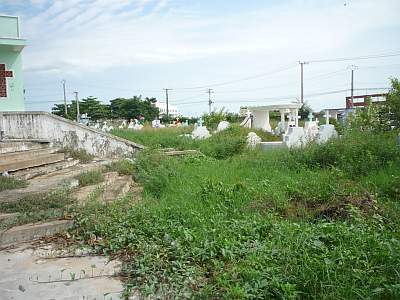 |
But then the association could find no record of that burial. Several phone calls later they said if we could identify the grave they might give approval, so the father and I drove to the cemetery and found the first daughter's grave which has no marker on it. We were met by a cemetery worker there and we asked if we could arrange for the second girl's burial at 1:00 PM. The worker agreed and showed us an empty plot, and relieved that we had finally got that settled, the father and I started back to Phnom Penh.
On the way the parish priest called to say that the director had telephoned him to say there was a misunderstanding: the cemetery worker had no authority to authorize the burial, the grave still had not been identified since there was no marker on it, and if things could proceed, the association would need a death certificate and a certification that there were no infectious diseases involved.
We proceeded on to the family home and I got to see the child's mother for the first time. She was sitting on the floor next to a cot with the baby's body on it, wrapped in a sheet, and she was surrounded by women from her country who had come to offer support. The mother was obviously saddened and was chanting, a type of keening, in the Urdu language. I could not understand what she was saying but her heartfelt grief was obvious. It was obvious at that point there could be no burial at 1:00 PM so I started calling back to people who had been calling to me during the morning to find out when the service would take place.
Because the baby had died before reaching the hospital, the hospital could not provide a death certificate so the father had to call the police who sent an officer to certify the death for the sangkat or district of the city. The parish priest then called back several times, negotiating between the family and the cemetery association, and finally he said the director had given authorization for the funeral.
The police officer said he would arrange the death certificate but it was almost lunch time so he could not produce anything until 2:00 PM. The father had already given him money to make this happen and said there would be another ten dollars if the certificate arrived before 1:00 PM. Somewhere along the line, the demand for a certificate about no disease stopped being mentioned and things seemed to be going ahead without it so I didn't mention it. The death certificate appeared by 1:00 o'clock.
The mother was chanting and the father was working with the police but I interrupted to plan times for the afternoon and the father said that perhaps the funeral service could be at 3:30 PM at the family home with the burial immediately afterwards out near the airport. Then I started home to prepare the services and to send more e-mails with the new time for the services. As I was leaving, I got another text message saying that it would cost $580 for the cemetery plot and for digging the grave. The father said he didn't have that much money at home, and because he needed to be with his wife and other children, I told him that I would get some money that was going to be delivered to my Maryknoll mailbox that day. It was there so I took that home with me and started preparing the ceremony and gathering the things I would need.
About 1:00 PM, the father called me from the office of the cemetery association. He had taken the death certificate there, required before a burial authorization could be issued, and then found that he had to pay for the plot, too, before the authorization would be granted. He and the director then came to my house in the second horrendous thunderstorm of the day (leftovers from a typhoon that hit Vietnam), and I gave them the money for the grave. Then the father went home and I went back to work.
At 3:00 PM I arrived at the family house and there was a considerably larger number of people there now. The baby was wrapped in a new white sheet and her mother was sitting beside her, much more at peace than earlier in the morning. I sat down beside her and she told me that she was much more peaceful now. She said that she had "prepared the baby for her journey" and that the baby had given her peace.
The father was worried about more rain coming when we were outside the house and at the cemetery so we started the ceremony quickly, even a little before the announced time. I had been thinking that there should be some music, some singing, but didn't know how we could manage that since the group was half Christian and half Muslim and from several different countries. But then the father asked me if the family could lead some singing. I was delighted to hear that! We started with Psalm 130 sung in Urdu and I was so impressed how all the family knew all the verses by heart.
The ceremony at home lasted about twenty-five minutes, with the gospel story of Mary and Martha, mourning their dead brother Lazarus, done in English and Urdu. Then there was a final blessing and it was time to go to the cemetery. I don't understand all the cultural background to it, but the mother did not go to the cemetery. None of the women did, just the men. I felt a pang for the mother who could not have that opportunity to grieve and really commit her daughter to the journey.
There was much anguish and grieving as an uncle picked up the little girl's body and placed it in the wooden box covered with white cloth that had been made that morning. Then two of the men carried the box downstairs and put it on the back seat of the SUV and the father and I got in the front and headed for the cemetery. As we drove the skies poured down rain again, heavily. I said a little prayer that it would stop by the time we got to the cemetery, and it started lessening as we approached and by the time we got there, there were just a few sprinkles coming down and soon even that stopped.
We walked back to the newly dug grave and gathered in the wet grass and weeds and the mud. The grave was just about three feet deep and now it had a lot of water in it from the rain storm, so the cemetery worker jumped down into the grave and started bailing it out. Several men started tearing small branches off the tree that was over the grave and placed them at the bottom so that the coffin would not sit in the water. Two pipes were set across the open grave and the little coffin was placed on them. Then there was a blessing of the grave.
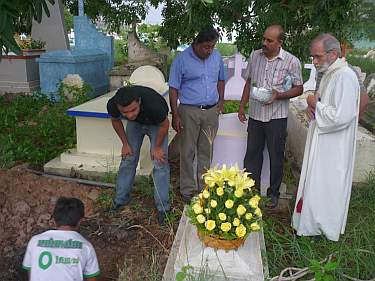 |
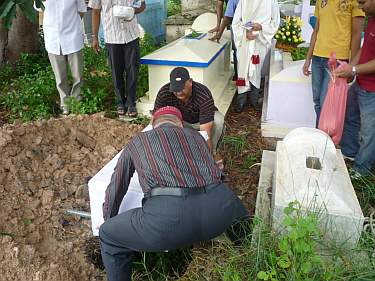 |
We offered the prayers committing the little girl's body to the earth from which it had come and then the coffin was opened for a last glimpse of the little girl and the sheet was pulled over her head. Then a relative produced a hammer and a small bag of nails and began to nail the coffin shut. Finally ropes were placed under it and it was lowered into the ground. More tree branches were placed on top of it, a little touch of respect, keeping the dirt from falling directly on top of the white cloth covering of the box.
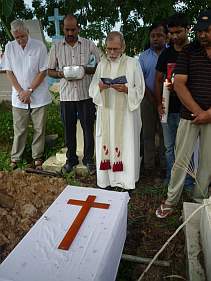 |
 |
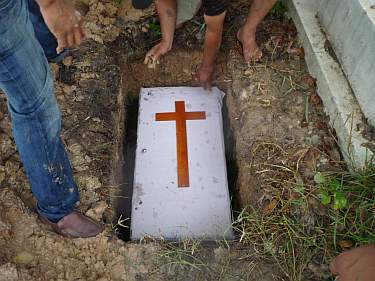 |
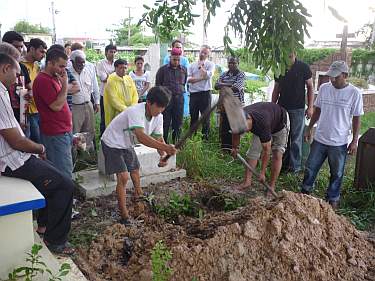 |